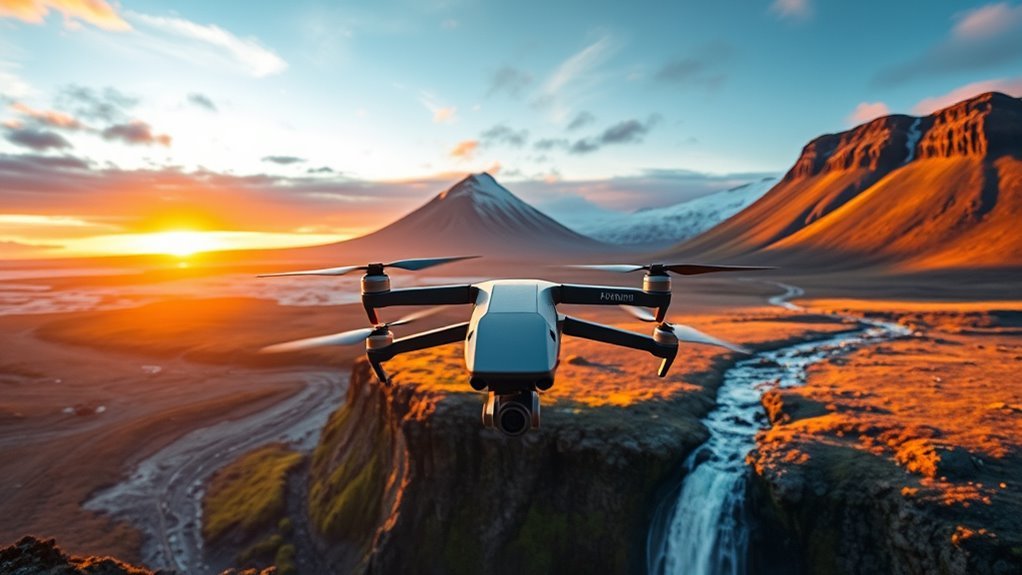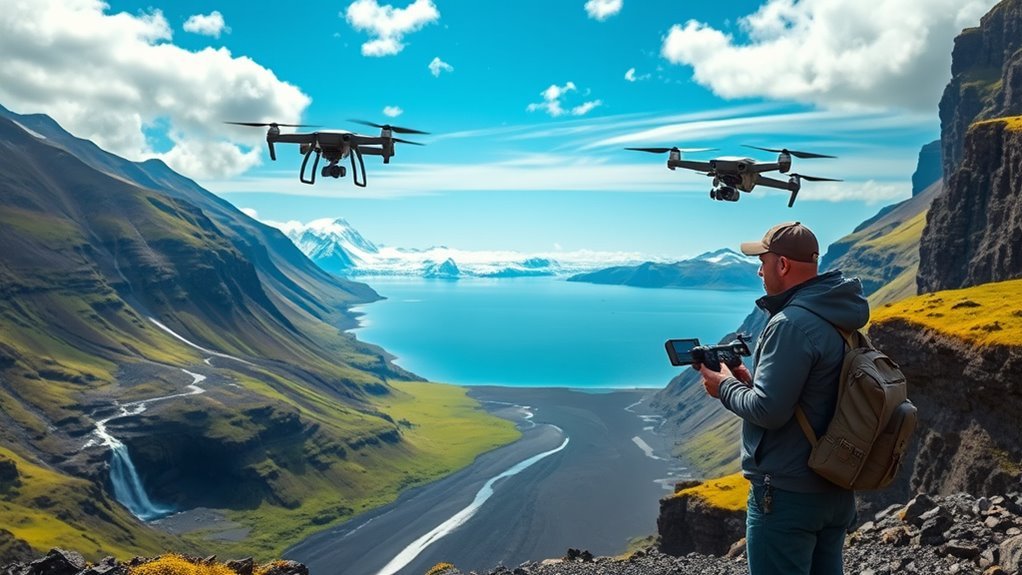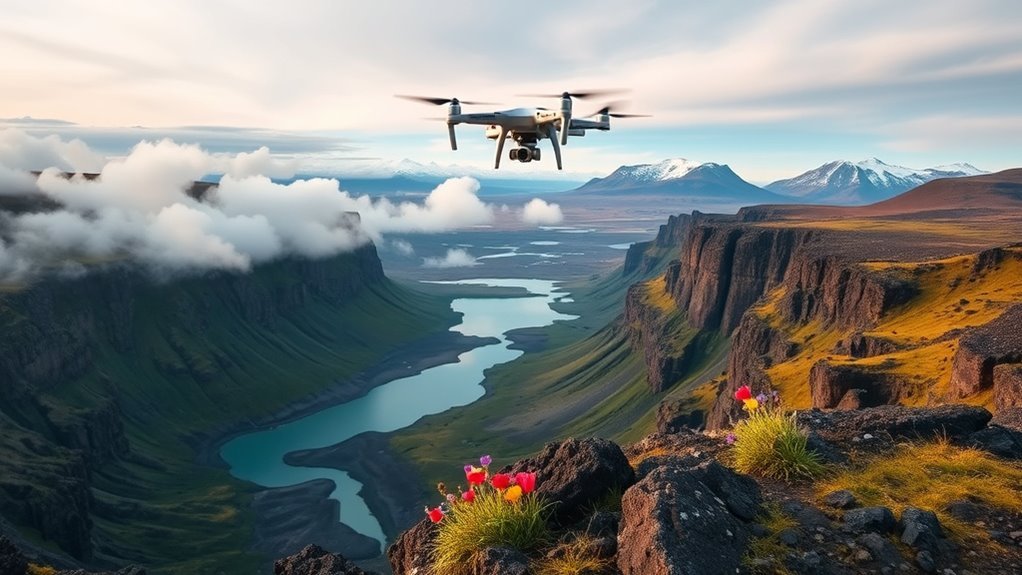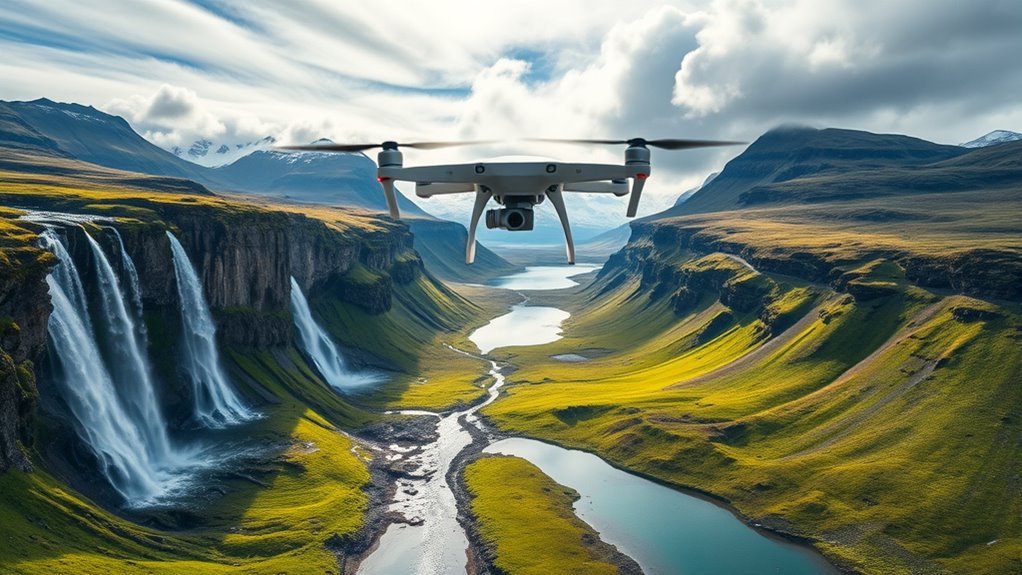To fly drones in Iceland, you need to follow specific regulations, obtain necessary licenses, and be aware of no-fly zones, especially around national parks and urban areas. Always keep your drone in sight, avoid crowds, and respect wildlife by maintaining safe distances. Liability insurance is recommended to cover potential damages. Engaging with local drone communities can enhance your experience and provide useful insights. There’s much more to explore about safe and responsible drone flying in Iceland.
Overview of Drone Regulations in Iceland

When you’re planning to fly a drone in Iceland, it’s essential to understand the country’s regulations to guarantee a safe and enjoyable experience. Iceland’s breathtaking landscapes offer incredible opportunities for aerial photography, but drone technology comes with specific rules. You’ll need to keep your drone within sight at all times and avoid flying over people or crowds. Additionally, there are restrictions in place around protected areas, such as national parks and wildlife reserves. Familiarizing yourself with these regulations will not only enhance your freedom while flying but also help protect Iceland’s stunning environment. By respecting these guidelines, you can capture breathtaking images while ensuring the safety of both yourself and others. Always stay informed before your flight!
Required Documentation for Drone Pilots

When flying drones in Iceland, you’ll need to guarantee you have the right documentation in place. This includes obtaining necessary licenses and permits, as well as understanding insurance and liability requirements. Being prepared with the right paperwork not only keeps you compliant but also protects you during your aerial adventures.
Necessary Licenses and Permits
Before you take to the skies with your drone in Iceland, it’s vital to understand the necessary licenses and permits required for compliance with local regulations. Familiarizing yourself with the drone licensing requirements is the first step to guarantee you’re flying legally and safely. Depending on your drone’s weight and intended use, you may need to obtain specific permits. The permit application process can vary, so make sure to check with the Icelandic Transport Authority for the latest guidelines. Whether you’re capturing stunning landscapes or documenting your adventures, having the right documentation not only keeps you compliant but also enhances your flying experience. So gear up, prepare your paperwork, and enjoy the freedom of Icelandic skies!
Insurance and Liability Requirements
While you’re preparing to fly your drone in Iceland, understanding the insurance and liability requirements is essential for protecting yourself and your equipment. You’ll want to secure liability coverage to safeguard against any potential damages or accidents. Icelandic regulations may not mandate specific insurance, but having thorough insurance options can provide peace of mind during your adventures. Consider looking into policies that cover both drone damage and third-party injuries. This way, you can focus on capturing stunning landscapes without the worry of unexpected costs. Always check with your insurance provider to confirm your coverage aligns with Iceland’s unique environment. By being informed and prepared, you can truly enjoy the freedom of flying your drone in this breathtaking country.
Understanding No-Fly Zones

When flying drones in Iceland, it’s essential to understand no-fly zones, which include designated protected areas and urban flight restrictions. These zones are in place to safeguard wildlife and guarantee public safety, so ignoring them can lead to serious consequences. Familiarizing yourself with these regulations will help you enjoy your drone experience while respecting the environment and local communities.
Designated Protected Areas
Although flying drones can offer stunning aerial views of Iceland’s breathtaking landscapes, understanding the designated protected areas and their associated no-fly zones is essential for every drone enthusiast. These zones are vital for wildlife conservation and reflect cultural sensitivity towards Iceland’s natural and historical sites. Ignoring these regulations not only risks hefty fines but can also disrupt the serene environment and local wildlife.
| Area Type | Examples | Restrictions |
|---|---|---|
| National Parks | Þingvellir, Vatnajökull | No drone flying allowed |
| Nature Reserves | Hornstrandir, Heimaey | Restricted zones within |
| Cultural Sites | Skálholt, Reykholt | Drone use requires permits |
Respecting these areas helps maintain Iceland’s beauty for future generations.
Urban Flight Restrictions
As you explore the urban landscapes of Iceland, it’s important to be aware of the specific flight restrictions that govern drone use in these areas. Major cities like Reykjavik have designated no-fly zones, which include government buildings, schools, and hospitals. Respecting urban drone etiquette is vital; always maintain a safe distance from crowds and private properties. Understanding city flight navigation can help you identify safe areas for flying, ensuring you’re compliant with regulations while enjoying your aerial adventure. Remember, each city may have unique rules, so double-check local guidelines before launching your drone. By following these restrictions, you’ll contribute to the safety and enjoyment of the urban environment for everyone. Happy flying!
Flying Drones in National Parks and Protected Areas
While exploring the breathtaking landscapes of Iceland’s national parks and protected areas, you might be tempted to capture stunning aerial footage with a drone. However, it’s vital to understand the regulations governing drone wildlife interactions and their environmental impact. Many parks prohibit drone usage to protect fragile ecosystems and prevent disturbances to wildlife. Respecting these rules not only guarantees your freedom to fly in the future but also safeguards the natural beauty you seek to capture. Before launching your drone, always research specific park regulations and consider how your flight might affect the environment. Additionally, maintaining a minimum distance from wildlife and nesting sites is essential to prevent disturbance. By doing so, you can enjoy the thrill of aerial photography while preserving the beauty of Iceland’s unique landscapes for generations to come.
Safety Guidelines for Drone Operation
When operating a drone in Iceland, it’s crucial to prioritize safety to guarantee both your well-being and that of others around you. Remember, drone safety isn’t just about following the rules; it’s about being responsible. Here are key flight precautions to keep in mind:
- Keep your drone within line of sight to avoid unexpected obstacles.
- Check weather conditions to prevent flying in strong winds or poor visibility.
- Avoid flying near people, animals, or sensitive environments, respecting their space.
- Familiarize yourself with local regulations to maintain compliance and protect your freedom to fly.
Tips for Capturing Stunning Aerial Photography
To capture stunning aerial photography in Iceland, it helps to plan your shots around the unique landscapes and lighting conditions. Start by exploring the rule of thirds for your aerial composition; this technique can lead to more dynamic images. Early mornings or late afternoons provide soft light, enhancing your photos. Experiment with different altitudes and angles to find the most compelling perspectives—don’t be afraid to adjust your drone’s height to create depth. Utilize natural lines in the landscape, like rivers or roads, to guide the viewer’s eye. Finally, keep your camera settings in mind; using a lower ISO can reduce noise and improve clarity. With these photography techniques, you’ll create breathtaking visuals that capture Iceland’s raw beauty.
Insurance and Liability Considerations
Before you take to the skies with your drone in Iceland, it’s essential to understand the insurance and liability factors that come with it. Having adequate insurance coverage can safeguard you against unexpected incidents. Also, be aware that some locations may require liability waivers to fly. Here are a few key points to reflect upon:
- Personal injury: Accidents can happen, and you’ll want to be covered.
- Property damage: Protect yourself against claims for damages caused by your drone.
- Legal requirements: Familiarize yourself with local laws and regulations.
- Flight zones: Some areas may have specific insurance needs.
Resources for Drone Pilots in Iceland
Steering through the world of drone piloting in Iceland can be an exhilarating experience, but having access to the right resources makes all the difference. Connecting with local drone communities is a fantastic way to share knowledge, tips, and experiences. These groups often host local meetups where you can network with fellow enthusiasts, learn about the latest regulations, and even discover some hidden flying spots across the stunning Icelandic landscape. Online forums and social media platforms also serve as excellent resources for real-time updates and advice from seasoned pilots. Whether you’re a novice or an experienced flyer, tapping into these resources can enhance your flying experience and help you navigate the unique challenges Iceland presents. So, get involved and enjoy the freedom!
Frequently Asked Questions
Can I Fly My Drone at Night in Iceland?
“Where there’s a will, there’s a way.” However, you can’t fly your drone at night in Iceland due to visibility requirements and strict night flying restrictions. Always check local regulations before planning your nighttime adventures.
Are There Specific Age Requirements for Drone Pilots?
Yes, there are age requirements for drone pilots. You’ll need to be at least 16 years old to guarantee proper pilot training and drone safety. Always prioritize safety as you explore the skies!
What Happens if I Break Drone Regulations?
What’s the thrill of flying if you face penalties? Breaking drone regulations can lead to legal consequences, including fines or even confiscation of equipment. Stay informed to enjoy your freedom responsibly and avoid unwanted trouble.
Can I Use My Drone for Commercial Purposes?
Yes, you can use your drone for commercial purposes, but you’ll need a commercial drone license and must meet drone insurance requirements. Ensuring compliance lets you enjoy the freedom of flying while operating legally.
Are There Any Drone Rental Services in Iceland?
Yes, you’ll find various drone rental options in Iceland. Popular locations like Reykjavik and the Golden Circle offer services, allowing you to explore breathtaking landscapes while capturing stunning aerial footage without the hassle of ownership.

